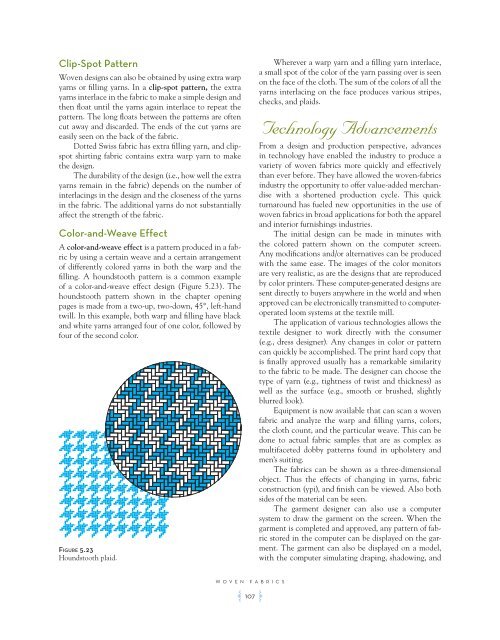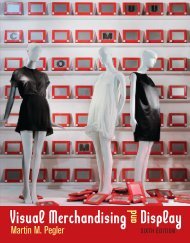Create successful ePaper yourself
Turn your PDF publications into a flip-book with our unique Google optimized e-Paper software.
Clip-Spot Pattern<br />
<strong>Woven</strong> designs can also be obtained by using extra warp<br />
yarns or filling yarns. In a clip-spot pattern, the extra<br />
yarns interlace in the fabric to make a simple design and<br />
then float until the yarns again interlace to repeat the<br />
pattern. The long floats between the patterns are often<br />
cut away and discarded. The ends of the cut yarns are<br />
easily seen on the back of the fabric.<br />
Dotted Swiss fabric has extra filling yarn, and clipspot<br />
shirting fabric contains extra warp yarn to make<br />
the design.<br />
The durability of the design (i.e., how well the extra<br />
yarns remain in the fabric) depends on the number of<br />
interlacings in the design and the closeness of the yarns<br />
in the fabric. The additional yarns do not substantially<br />
affect the strength of the fabric.<br />
Color-and-Weave Effect<br />
A color-and-weave effect is a pattern produced in a fabric<br />
by using a certain weave and a certain arrangement<br />
of differently colored yarns in both the warp and the<br />
filling. A houndstooth pattern is a common example<br />
of a color-and-weave effect design (Figure 5.23). The<br />
houndstooth pattern shown in the chapter opening<br />
pages is made from a two-up, two-down, 45°, left-hand<br />
twill. In this example, both warp and filling have black<br />
and white yarns arranged four of one color, followed by<br />
four of the second color.<br />
Figure 5.23<br />
Houndstooth plaid.<br />
WOVEN FABRICS<br />
A 107 F<br />
Wherever a warp yarn and a filling yarn interlace,<br />
a small spot of the color of the yarn passing over is seen<br />
on the face of the cloth. The sum of the colors of all the<br />
yarns interlacing on the face produces various stripes,<br />
checks, and plaids.<br />
Technology Advancements<br />
From a design and production perspective, advances<br />
in technology have enabled the industry to produce a<br />
variety of woven fabrics more quickly and effectively<br />
than ever before. They have allowed the woven-fabrics<br />
industry the opportunity to offer value-added merchandise<br />
with a shortened production cycle. This quick<br />
turnaround has fueled new opportunities in the use of<br />
woven fabrics in broad applications for both the apparel<br />
and interior furnishings industries.<br />
The initial design can be made in minutes with<br />
the colored pattern shown on the computer screen.<br />
Any modifications and/or alternatives can be produced<br />
with the same ease. The images of the color monitors<br />
are very realistic, as are the designs that are reproduced<br />
by color printers. These computer-generated designs are<br />
sent directly to buyers anywhere in the world and when<br />
approved can be electronically transmitted to computeroperated<br />
loom systems at the textile mill.<br />
The application of various technologies allows the<br />
textile designer to work directly with the consumer<br />
(e.g., dress designer). Any changes in color or pattern<br />
can quickly be accomplished. The print hard copy that<br />
is finally approved usually has a remarkable similarity<br />
to the fabric to be made. The designer can choose the<br />
type of yarn (e.g., tightness of twist and thickness) as<br />
well as the surface (e.g., smooth or brushed, slightly<br />
blurred look).<br />
Equipment is now available that can scan a woven<br />
fabric and analyze the warp and filling yarns, colors,<br />
the cloth count, and the particular weave. This can be<br />
done to actual fabric samples that are as complex as<br />
multifaceted dobby patterns found in upholstery and<br />
men’s suiting.<br />
The fabrics can be shown as a three-dimensional<br />
object. Thus the effects of changing in yarns, fabric<br />
construction (ypi), and finish can be viewed. Also both<br />
sides of the material can be seen.<br />
The garment designer can also use a computer<br />
system to draw the garment on the screen. When the<br />
garment is completed and approved, any pattern of fabric<br />
stored in the computer can be displayed on the garment.<br />
The garment can also be displayed on a model,<br />
with the computer simulating draping, shadowing, and













